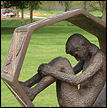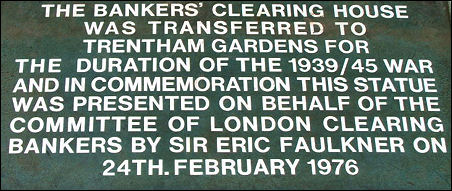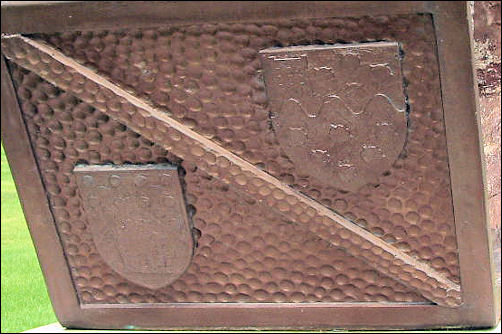| thepotteries.org |
where is it? test your knowledge of Stoke-on-Trent

Statue in Trentham Gardens
commemorating the
transfer of the clearing banks in the Second World War

The Bankers' Clearing House
was transferred to
Trentham Gardens for
the duration of the 1939/45 war
and in commemoration this statue
was presented on behalf of the
Committee of London Clearing
Bankers by Sir Eric Faulkner on
24th February 1976

The statue has seven sides - as
a fifty pence coin - it sits on one side and
the other six are visible.
Each side is divided diagonally and the
banks' crests stand out against a bubble-type background surface.
The figure inside the coin is in a semi-foetal position with the knees tucked up
near the chin.
Sculptor: Robert Berkoff
media: Fibre glass with a bronze patina
|

This statue represents the rim
of a 50p coin with the crests of
the clearing banks of the time
shown on the visible sides
and enveloping Embryo Man.
It symbolises the all-embracing
concern of the clearing banks
for the financial well-being
of their customers

bottom left: the arms of the National
Provincial Bank
top right: the arms of the former Westminster Bank
On 01 January 1970, Westminster Bank merged with
National Provincial Bank Ltd. to form National Westminster Bank Ltd

bottom left: the logo of Lloyds Bank
The black horse device dates from 1677 when Humphrey Stokes
adopted it as sign for his shop.
Stokes was a goldsmith and "keeper of the running cashes," an early term for
banker.
When the bank took over the site in 1884, it retained the black horse as its
symbol

bottom left: the logo of The Bank of England

top right: the arms of the former
Midland Bank
a golden griffin surrounded by golden dots

top right - the logo of Martins Bank
bottom left: the logo of Barclays Bank
In 1969 Martins Bank was taken over by Barclays


The restoration of this statue
was funded by
Bank of England
Barclays Bank plc
Lloyds Bank plc
Midland Bank plc
National Westminster Bank plc
The Royal Bank of Scotland plc
December 1995
|
Trentham — A Teenager’s Memories by Estelle Davies I was 17 when the War started, working at the Stoke branch of Barclays Bank and living in Trent Vale (in the same street as the footballer Stanley Matthews as it happens, although I’m not a big football fan). I applied for war work, I’d have liked to have joined the Wrens, but they would not take me as I was in a reserved occupation. I had to carry on working at the bank and do firewatching instead. After the air attacks on London it was decided to move
the Bank of England out of the capital for safety, I think it was in 1940
(actually 1939). All the major clearing banks had staff based there, and I was transferred to the Barclays section. Each bank had its own section in the ballroom and the foreign section was on the stage. A lot of the staff were moved up from London and billeted in the local area. They didn’t really like it, being used to a big city, and kept to themselves pretty much as they knew each other. They called themselves the Outcasts, and used to organise dances and concerts for their own entertainment as there was not much else to do. They are mentioned in most of the books and articles written about Trentham during the war but it seems to be forgotten that not all the staff were Londoners, there were local people there as well. I didn’t mix with them much, we hadn’t a lot in common and I was busy at home keeping house for my father with my two sisters. "Estelle Skinner (née Davies) WW2 People's War"
photo: © Potteries Museum & Art Gallery
|


The clearing operation at
Trentham during the Second World War
photo: Cheque and Credit Clearing Company